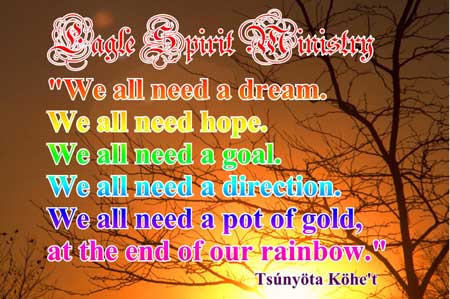

 |
 |
 |
||
 |
||
|
The Old Ones tell that dreams hold great power and drift about at night before coming to the sleeping ones. To keep the dreamer safe, the Old Ones created a special web, the Dream Catcher, to hang above their sleeping places. When dreams travelled the web paths, the bad dreams lost their way and were entangled, disappearing with the first rays of daybreak. The good dreams, knowing the way, passed through the centre and were guided gently to the sleeping ones. The Lakota Dream Catcher Legend works in reverse. |
||
 |
||
 |
||
|
Long ago when the world was young, an old Lakota spiritual leader was on a high mountain and had a vision. In his vision, Iktomi, the great trickster and teacher of wisdom, appeared in the form of a spider. Iktomi spoke to the elder in a scared language that only the spiritual leaders of the Lakota could understand. As he spoke Iktomi, the spider, took the elder's willow hoop which had feathers, horse hairs, beads and offerings on it and began to spin a web. Iktomi spoke to the elder about the cycles of life, how we begin our lives as infants and we move on to childhood, and then to adulthood. Finally, we go to old age where we must be taken care of as infants, completing the cycle. Iktomi said, "In each time of life there are many forces and different directions that can help, or interfere with the harmony of nature, and also with the great spirit and all of his wonderful teachings." Iktomi gave the web to the Lakota elder and said, "See, the web is a perfect circle, but there is a hole in the centre of the circle. If you believe in the great spirit, the web will catch your good dreams and ideas, and the bad ones will go through the hole. Use the web to help yourself and your people to reach your goals and make good use of your people's ideas, dreams and visions." The Lakota elder passed on his vision to his people and now the Lakota's use the dream catcher as the web of their life. It is hung above their beds, or in their home to sift their dreams and visions. The good of their dreams is captured in the web of life and carried with them, but the evil in their dreams escapes through the centre hole, and are no longer part of them. |
||
 |
||
 |
||
| Long ago in the ancient world of
the Ojibwe Nation, the Clans were all located in one general area of that
place known as Turtle Island. This is the way that the old Ojibwe storytellers
say how Asibikaashi (Spider Woman) helped Wanabozhoo bring giizis (sun)
back to the people. To this day, Asibikaashi will build her special lodge
before dawn. If you are awake at dawn, as you should be, look for her lodge
and you will see this miracle of how she captured the sunrise as the light
sparkles on the dew which is gathered there.
Asibikaasi took care of her children, the people of the land, and she continues to do so to this day. When the Ojibwe Nation dispersed to the four corners of North America, to fill a prophecy, Asibikaashi had a difficult time making her journey to all those cradle boards, so the mothers, sisters and Nokomis (grandmothers) took up the practice of weaving the magical webs for the new babies using willow hoops and sinew or cordage made from plants. It is in the shape of a circle to represent how giizis travels each day across the sky. The dream catcher will filter out all the bad bawedjigewin (dreams) and allow only good thoughts to enter into our minds when we are just abinooji. You will see a small hole in the centre of each dream catcher where those good bawadjige may come through. With the first rays of sunlight, the bad dreams would perish. When we see little asibikaashi, we should not fear her, but instead respect and protect her. In honour of their origin, the number of points where the web connected to the hoop numbered eight for Spider Woman's eight legs or seven for the Seven Prophecies. It was traditional to put a feather in the centre of the dream catcher; which means breath, or air and is essential for life. Dream catchers made of willow and sinew are for children, and they are not meant to last. Eventually the willow dries out and the tension of the sinew collapses the dream catcher, representing the temporary period of youth. Adults should use dream catchers of woven fibre which is made up to reflect their adult dreams. |
||
 |
||
| It is customary in many parts of Canada and the North-eastern U.S. to have the dream catchers be a tear-drop or snow shoe shape, instead of a circle. | ||
 |
||
 |
||
|